1. Sunday Family Dinners

There was once a time when Sundays were all about slowing down and reconnecting with family. Sunday family dinners were a cherished tradition in countless households, where every member would gather around the table to share a meal, laughter, and stories from the week. These meals weren’t just about food, but about building relationships, passing down family traditions, and creating lasting memories. In today’s fast-paced world, where everyone’s schedules are hectic and unpredictable, this practice has largely disappeared.
Reviving the Sunday family dinner could be the antidote to our disconnected lives. It’s a simple yet powerful way to cultivate deeper connections, allowing time for meaningful conversation and reflection. In a world full of distractions, these dinners can help refocus our priorities on what truly matters: family, community, and shared experiences. The act of gathering around the table offers a perfect opportunity for intergenerational storytelling, bonding, and reinforcing familial ties, ultimately fostering a sense of belonging and unity that can enrich every member’s life.
2. Barn Raisings
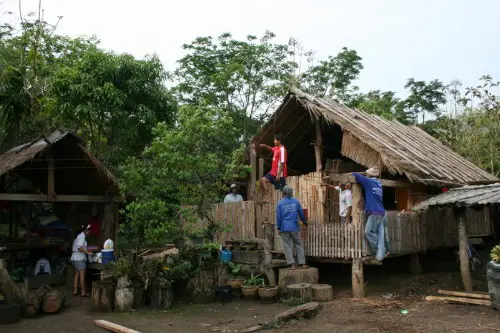
Barn raisings were once a staple of rural American life, where communities came together to assist a family in need of building a barn, house, or other structure. These events were about more than just construction; they were about cooperation, unity, and collective effort. Neighbors would spend a day or more working side by side, offering their labor and support, knowing that they would receive the same in return when they needed it. In the past, these communal efforts were an essential part of rural life, as it helped families thrive without having to do everything alone.
Today, though we may not need barns, the spirit of community-building remains just as important. Barn raisings serve as a reminder of the power of working together toward a common goal, and that same principle can be applied to modern-day efforts like urban gardening, environmental clean-ups, or local charity projects. In a time when many of us feel disconnected from our neighbors, a revival of this tradition could help reforge those bonds and remind us of the importance of collective action. It would help reawaken our sense of community and encourage collaborative, hands-on efforts to improve the places we live.
3. Porch Sitting

Porch sitting used to be an essential part of American life, particularly in small towns and rural areas. The front porch served as a gathering place for families and neighbors, where people could relax, converse, and watch the world go by. It was where communities came together to share news, enjoy the weather, and bond over simple pleasures. The porch was often the first place visitors would be welcomed, and it provided an opportunity for spontaneous connections between strangers and old friends alike.
In today’s society, the front porch has largely been replaced by indoor activities, and many homes have little to no outdoor seating areas. However, bringing back the tradition of porch sitting could have profound effects on our sense of community and well-being. Imagine sitting on a porch with your neighbors, chatting about the day or simply enjoying the silence together. This simple act fosters connection, encourages face-to-face conversations, and helps us slow down in a world that often feels like it’s moving too fast. Reviving this tradition could help us reclaim the joys of outdoor living and reconnect with those around us.
4. Writing Letters by Hand

In a world dominated by digital communication, the art of writing handwritten letters has slowly faded into the background. In past generations, writing letters by hand was a deeply personal and thoughtful way to communicate with loved ones, friends, or even acquaintances. Each letter was carefully crafted, often taking hours to write, and contained words that held a weight of meaning. The intimacy of handwriting added a personal touch that text messages or emails simply can’t replicate. Letters were something to be cherished, held onto, and reread over time.
Bringing back handwritten letters could provide a much-needed antidote to the impersonal nature of modern communication. Writing a letter requires us to slow down, reflect, and convey our feelings in a deliberate, thoughtful manner. It’s a meaningful way to stay in touch with those who matter, whether they live near or far. Plus, receiving a handwritten letter in the mail feels like an event in itself—an unexpected moment of joy in a world of instant messages. By reviving this lost art, we could reintroduce a level of care and connection that has all but disappeared in the digital age.
5. Town Hall Meetings
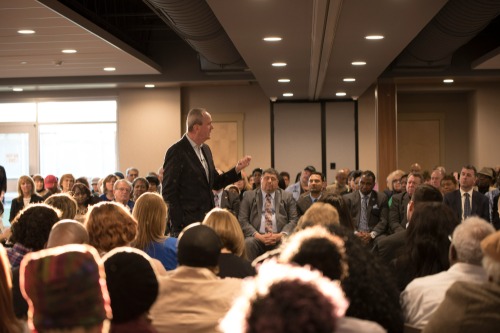
Before the advent of the internet, town hall meetings were the primary way that citizens engaged with their local leaders and each other. These gatherings allowed people to voice their concerns, ask questions, and participate in shaping the future of their communities. Whether discussing local policies, upcoming events, or neighborhood issues, town halls served as an essential venue for democratic participation and civic engagement. They fostered transparency, accountability, and a sense of collective ownership over the decision-making process.
In today’s world, many of these town hall meetings have been replaced by online forums or even social media posts, which can lack the depth and personal connection that face-to-face interactions provide. Restoring the tradition of town hall meetings could help bridge the gap between local government and the public, providing a space for direct dialogue and collaboration. It would offer citizens an opportunity to voice their concerns and work with leaders on the issues that matter most. With the rise of digital communication, town halls could be the perfect combination of old-fashioned interaction and modern-day convenience, revitalizing local democracy and civic pride.
6. Block Parties
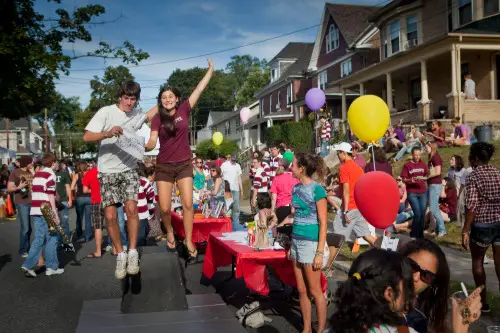
Block parties were once a summer tradition that brought entire neighborhoods together for a day of fun, food, and celebration. These community events allowed neighbors to meet one another, build friendships, and create lasting memories, often featuring barbecues, music, games, and even talent shows. Block parties were an opportunity to break down social barriers and forge new connections, while also celebrating the diversity of the neighborhood. They were a symbol of the communal spirit that made small-town America so special.
In the modern era, many of us live in cities where it’s easy to feel isolated from our neighbors. Reviving the tradition of block parties could be a powerful way to rebuild a sense of community and foster inclusivity. A block party can serve as a celebration of diversity, where people from different backgrounds and cultures can come together to share food, music, and stories. It’s a fun, low-cost way to meet new people, strengthen relationships, and create a positive, welcoming atmosphere in any neighborhood. Plus, a block party is the perfect antidote to the busy, often impersonal, pace of city living.
7. Storytelling Nights
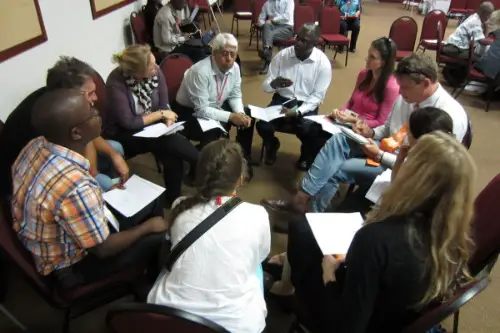
Before the days of television and streaming platforms, families and communities would gather around the hearth to share stories. These storytelling nights were a chance to pass down oral traditions, recount personal experiences, and let creativity run wild. From folk tales to family histories, storytelling was an essential way to bond, educate, and entertain. It also helped preserve the cultural values and knowledge of previous generations, often offering life lessons through entertaining narratives.
In today’s digital world, we often turn to screens for entertainment, and face-to-face storytelling has become a rare occurrence. Bringing back storytelling nights could provide an opportunity to reconnect with our creativity, imagination, and history. Whether it’s sharing a funny anecdote from childhood, telling a ghost story, or recounting an important life event, storytelling encourages deep listening and connection. It allows us to engage with one another on a personal level and creates a shared experience that can strengthen relationships and build community. Additionally, storytelling nights offer a screen-free way to unwind and connect with others, fostering a sense of togetherness in a technology-driven world.
8. Penny Candy Stores
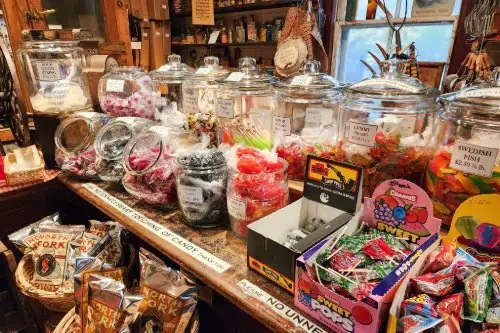
Penny candy stores were once the epitome of childhood joy. These small, independent candy shops were a place where children could spend their hard-earned pennies on sweets, from lollipops to licorice sticks. The excitement of walking into the candy store, choosing your treats, and savoring the simple pleasure of something sweet made it a treasured tradition for generations. It was more than just about candy—it was about the experience, the memories, and the joy of indulging in something small yet special.
Bringing back penny candy stores could offer a delightful escape from today’s commercialized world. Independent candy shops could provide a nostalgic experience, offering locally made treats and a personal touch that larger chain stores can’t replicate. They could also serve as gathering spots for families, where children can make their own choices, learn about local businesses, and experience the joy of indulging in a treat. Supporting these small shops would also help reinvigorate local economies and strengthen community ties. In a time when big-box retailers dominate, reviving penny candy stores could be a sweet way to bring back old-fashioned charm and support small businesses.
9. Sewing Circles
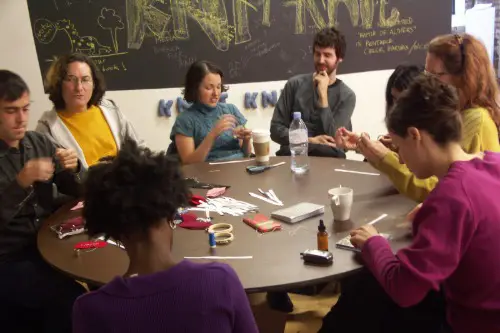
Sewing circles were once a central part of many communities, especially in rural areas, where women would gather to sew, quilt, knit, or crochet. These circles weren’t simply about creating beautiful or useful items, but about sharing stories, offering support, and building relationships. The rhythmic sound of sewing machines or needles weaving through fabric was accompanied by laughter, conversation, and the exchange of advice and life lessons. These gatherings were often seen as an opportunity to bond with others, teach skills, and maintain close-knit communities.
In today’s world, where many of us are disconnected from hands-on crafts, reviving sewing circles could offer a meaningful way to foster creativity, community, and connection. In addition to creating beautiful handcrafted items, these gatherings can provide a space for people to support one another in a fast-paced world. Sewing circles can be intergenerational, allowing older generations to pass on skills to younger ones, while also being a place to discuss everything from personal challenges to current events. Bringing this tradition back could help people slow down, embrace craftsmanship, and find comfort in the shared experience of creating something by hand.
10. Dancing in the Street
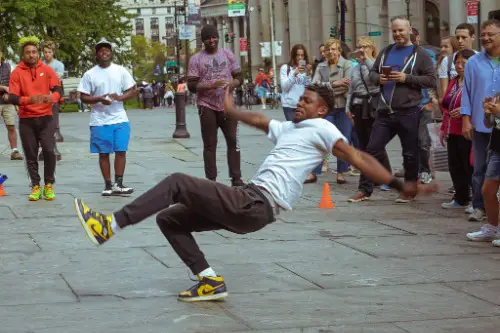
In the past, it wasn’t uncommon for communities to host public dances, often right in the middle of Main Street or in a local park. People would gather, dressed in their best clothes, to dance under the stars or to the lively rhythms of local bands. These dances were a celebration of community, of joy, and of togetherness. The sense of freedom and connection was palpable as people of all ages joined in, whether they were experienced dancers or simply there to enjoy the music and the company of others.
Reviving the tradition of dancing in the street could help reinvigorate our sense of community and fun. Imagine an evening where the whole neighborhood gathers to dance to live music, perhaps after a day of a local festival or market. It would be a way to get people of all generations together, moving, laughing, and celebrating life. In a world where many of us are often isolated in our homes, this tradition could help reconnect us to the joy of spontaneous celebration. Dancing in the street would offer a public, communal experience that allows everyone to participate in a shared, uplifting moment, reinforcing the idea that life is meant to be enjoyed together.
11. Ice Cream Socials
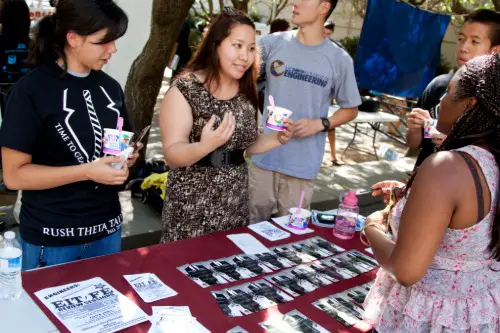
Ice cream socials were once an iconic American tradition, especially during summer months. Communities would come together to enjoy bowls or cones of ice cream in all sorts of flavors, often at local parks, schoolyards, or even church events. These gatherings were a perfect blend of indulgence and social interaction, providing a fun, low-cost way for families to bond, make new friends, and celebrate the simple joy of a cold, creamy treat. Ice cream socials were also a way to raise funds for causes, as people often came together to support local charities or school projects while enjoying a sweet, shared experience.
Reviving ice cream socials would not only rekindle fond memories for many but also provide a perfect way to foster community spirit in today’s busy world. These events offer something for everyone: kids can enjoy their favorite flavors, adults can mingle, and families can spend quality time together outdoors. It could also serve as a great way for newcomers to meet their neighbors in a relaxed and welcoming environment. Furthermore, ice cream socials are incredibly versatile—they can be part of larger festivals, held as fundraisers, or simply as a spontaneous way to bring people together. The revival of this tradition would encourage both community engagement and the shared joy of a delicious treat.
12. Victory Gardens
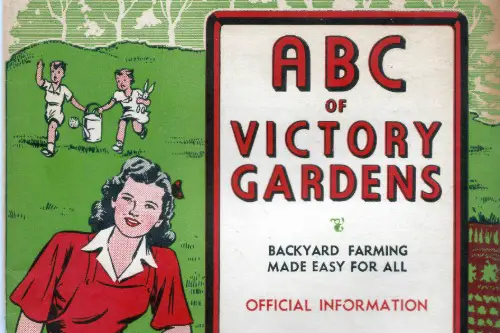
During World War II, Americans were encouraged to plant “Victory Gardens” to help support the war effort by growing their own food. These gardens not only helped alleviate food shortages but also instilled a sense of pride and self-sufficiency. People of all ages—whether they lived in urban areas or rural towns—took to their backyards, front yards, and even vacant lots to plant vegetables, fruits, and herbs. Victory Gardens became symbols of resilience and community, as people worked together to meet the challenges of the time.
In today’s world, the revival of Victory Gardens could serve multiple benefits. Growing our own food can reduce our reliance on commercial agriculture, lower our environmental footprint, and increase our food security. It also offers an opportunity to foster sustainability, teach children about nature, and even grow healthy, organic produce in small urban spaces. Communities could come together to create shared gardens, teach gardening skills, and grow food for local food banks, all while reinforcing the idea of sustainability and food independence. A return to Victory Gardens could not only help fight modern challenges such as food insecurity but also bring a sense of empowerment and connection back to the act of growing food.
13. Drive-In Movies
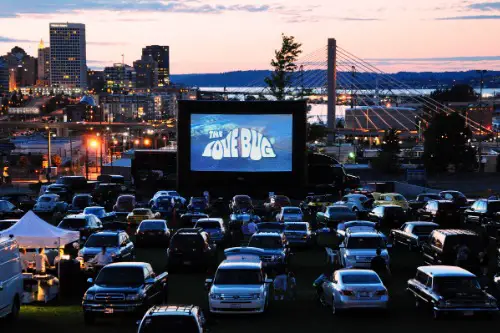
Drive-in movies were a beloved American tradition, particularly in the mid-20th century, when families and couples would flock to outdoor theaters to enjoy a film from the comfort of their cars. With the rise of convenience and low-cost entertainment options, drive-ins became a mainstay for summer nights, offering a mix of nostalgia, fun, and romance. Drive-in theaters often had a unique atmosphere, with large screens, car speakers, and even food stands offering popcorn and hot dogs. It was a special outing, whether it was for a double feature or a first date.
Bringing back drive-in movies could be a way to offer a unique, nostalgic experience while also providing an alternative to traditional movie theaters. These outdoor cinemas could be integrated into modern communities by hosting family-friendly events, retro movie nights, or community festivals. With the current popularity of outdoor activities and nostalgia for the past, the revival of drive-in theaters could tap into both modern trends and old-fashioned charm. Drive-ins also offer an easy way for families to enjoy movies together while maintaining a sense of privacy and comfort. In a time where social activities are increasingly digital, this would be a fun, interactive way to spend time outdoors, celebrating film and community in a relaxed, open-air setting.
14. Maypole Dancing
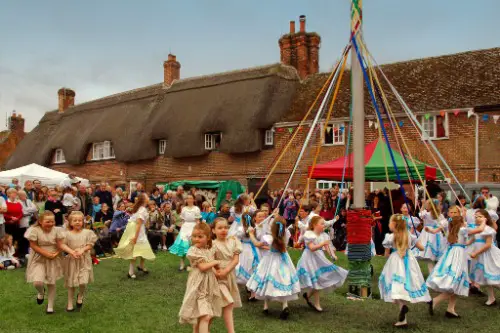
Maypole dancing is a centuries-old tradition that has roots in European folklore, often celebrated during spring festivals. A group of dancers would circle a tall pole adorned with ribbons, weaving and intertwining the ribbons as they danced to cheerful music. The tradition symbolizes the arrival of spring, the renewal of life, and the connection between people and nature. Maypole dancing is colorful, lively, and full of joy, and it’s been a highlight of many community celebrations, especially in schools or villages that wanted to honor the change of seasons.
Reviving Maypole dancing could bring an enchanting touch of whimsy to modern festivals and school events. Not only would it offer a fun, community-centered way to celebrate spring, but it would also introduce young generations to a piece of cultural history. Schools, local parks, and town festivals could easily incorporate Maypole dancing into their annual activities, encouraging both children and adults to participate. The act of weaving the ribbons together as part of a group creates a tangible sense of unity and collaboration, making it more than just a fun activity but a way to celebrate the shared experiences that connect us all. Bringing back this tradition could help revitalize cultural celebrations, adding a sense of festive tradition and creative expression to modern-day festivities.
15. Apprenticeships
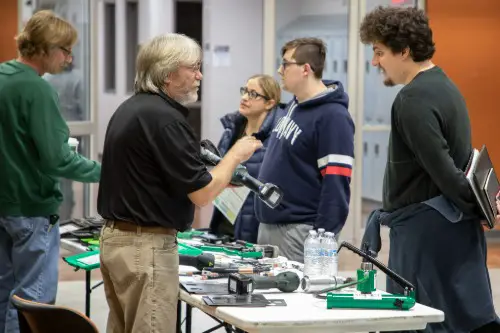
Before the rise of formal higher education, apprenticeships were a common and respected way for young people to learn a trade. The apprenticeship system allowed individuals to gain hands-on experience while working under the guidance of skilled mentors, ensuring that knowledge was passed down directly. In fields such as blacksmithing, carpentry, tailoring, and even baking, the knowledge and skills learned through apprenticeships were invaluable and often led to lifelong careers. Apprenticeships provided a clear path to employment without the burden of college tuition, offering practical, real-world experience that prepared individuals for the workforce.
Reintroducing apprenticeships could provide an alternative, debt-free route to a successful career for many young people today. With the rising costs of higher education and the changing demands of the job market, hands-on training offers an effective way to gain skills without the burden of student loan debt. Many industries, from technology to construction, could benefit from apprenticeship programs, as they allow young people to learn directly from experienced professionals. Apprenticeships also help preserve valuable trades and knowledge that may otherwise be lost. By bringing this tradition back, we could help build a workforce that is skilled, diverse, and equipped to tackle the challenges of a rapidly changing economy.
It’s fascinating how these traditions reflect values like community, creativity, and resilience—qualities we still crave today. Let’s take inspiration from the past to enrich the present!


